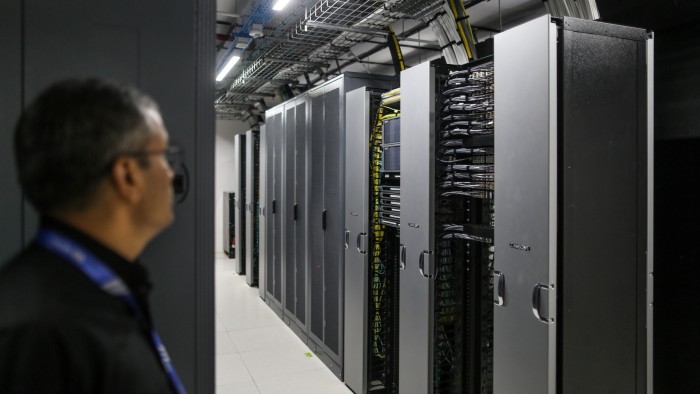Indian telecom giant Airtel is planning to double the capacity of its data centre business in less than three years, as growing domestic internet consumption and increasing artificial intelligence adoption drive unprecedented growth.
Ashish Arora, chief executive of Airtel subsidiary Nxtra, the domestic leader in data centres, told the Financial Times it would invest about $600mn in its latest round of expansion to achieve nearly 400 megawatts in capacity by the end of 2027.
It was also gearing up for further growth over the next five to seven years, he said, aiming to be the number one or two player.
Data centre owners use megawatts as a measure of size, describing their capacity or the amount of power their facilities can draw from the grid, and also for how they charge companies, based on how much power their dedicated servers use.
Leading Indian conglomerates have been placing large bets on a domestic industry that recorded $1.2bn in revenues in 2024 and has been growing at more than 20 per cent a year, as demand grows and international cloud service providers — such as Amazon’s AWS, Microsoft’s Azure and Google Cloud — increase their footprint.
India could become a regional data centre hub, with already cheap pricing being driven down further by increased competition, and the government pushing for almost all domestic data to be stored locally, say analysts. The industry can also draw on a vast talent pool, with India’s 375,000 tech workers proficient in AI being second in numbers only to the US, according to CBRE figures.
But the projected growth in this power-hungry sector could also put a strain on already struggling state-owned grids.
In 2022, before the data centre boom, the Indian government projected a 6.4 per cent annual growth in energy consumption until 2030, but according to the Council on Energy, Environment and Water, usage is growing at 9 per cent annually. “Existing planned capacities will be inadequate,” CEEW said, even if India meets its goal of creating 500 gigawatts of clean energy.
That growth could lift data centres’ share of domestic electricity consumption to more than 3 per cent by the end of the decade from 0.5 per cent today, according to a November report by Nomura.
Labanya Jena, a New Delhi-based consultant with the Institute for Energy Economics and Financial Analysis, said that figure could be an underestimate, “given the amount of data consumption by people”.
As consumers spend more time on streaming apps, ordering online and shifting towards digital transactions, “we are seeing a lot of domestic consumption, so that as well is going to fuel the domestic data centre growth”, said Devi Shankar, executive director at real estate company Anarock.
In a report published in April, Shankar noted India’s average monthly data consumption per user had nearly doubled to 21.1 gigabytes in the five years to 2024. During the same period, India’s data centre capacity jumped to 1.4GW from 590MW and is expected to pass 9GW by 2030.
Asia’s richest man, Mukesh Ambani, announced last year that “gigawatt-scale AI-ready” data centres would be set up in the western state of Gujarat, to be fed by his company’s green energy projects. A person aware of the details said the centres’ capacity could increase, depending on demand.
Similarly, the Adani Group, a domestic leader in green energy led by billionaire Gautam Adani, has partnered with US firm EdgeConneX to build 1GW of data centre capacity by the end of the decade.
“This market has exploded, a lot of new entrants have come,” Airtel’s Arora said. While Reliance and Adani are both new to the sector, Nxtra, in which Carlyle has a 24 per cent stake, is already among the top three in capacity, along with Japan’s NTT and Singapore’s STT.
Yet India is still “significantly underpenetrated” with just 1MW of data centre capacity per million users, compared with 51MW in the US and 4MW in China, rating agency CareEdge said last year, noting that India generates about 20 per cent of global data but just 3 per cent of data centre capacity.
Anarock’s Shankar said only 40 per cent of shared data centre capacity was being taken up by international cloud service providers, with the rest used by Indian businesses. Of these, the financial sector was responsible for 90 per cent of consumption, as a domestic frontrunner in adopting new tech and AI for its customers.
An increasingly crowded sector has made pricing so competitive that India offers some of the cheapest rates in the region at around $80 per kilowatt per month, compared to nearly $200 in Indonesia, according to Shankar.
But Nxtra’s Arora said the capacity of state-owned power grids could become a significant challenge. “The kind of scale which a lot of these clusters are projecting in terms of data centre capacities, in most places, grids are not geared up for it,” he said.
Such infrastructure upgrades were a relatively capital-intensive activity, he said, and most of the state power distribution companies “aren’t so financially healthy”, adding that India still had the land, power and capabilities to build tech infrastructure,
“So,” Arora added, “definitely that should become one of the areas in time . . . where India will start serving the world.”
